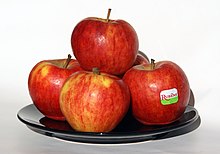
The McIntosh, McIntosh Red, or colloquially the Mac, is an apple cultivar, the national apple of Canada. The fruit has red and green skin, a tart flavour, and tender white flesh, which ripens in late September. In the 20th century, it was the most popular cultivar in Eastern Canada and New England, and is considered an all-purpose apple, suitable both for cooking and eating raw.

Cox's Orange Pippin, in Britain often referred to simply as Cox, is an apple cultivar first grown in 1825, at Colnbrook in Buckinghamshire, England, by the retired brewer and horticulturist Richard Cox. Though the parentage of the cultivar is unknown, Ribston Pippin seems a likely candidate. DNA analysis of major apple pedigrees has suggested Margil as the parent of Cox, with Ribston Pippin being another Margil seedling. The variety was introduced for sale by the 1850s by Charles Turner, and grown commercially from the 1860s, particularly in the Vale of Evesham in Worcestershire, and later in Kent. A paper by Howard et al seems to suggest that the Cox Orange Pippin is a hybrid between the Cultivars: Rosemary Russet and Margil based on the SNP data 7

Red Delicious is a type of apple with a red exterior and sweet taste that was first recognized in Madison County, Iowa, in 1872. Today, the name Red Delicious comprises more than 50 cultivars. It was the most produced cultivar in the United States from 1968 to 2018, when it was surpassed by Gala.

Gala is an McIntosh apple cultivar with a sweet, mild flavor, a crisp but not hard texture, and a striped or mottled orange or reddish appearance. Originating from New Zealand in the 1930s, similar to most named apples, it is clonally propagated. In 2018, it surpassed Red Delicious as the apple cultivar with the highest production in the United States, according to the US Apple Association. It was the first time in over 50 years that any cultivar was produced more than Red Delicious.

Honeycrisp is an apple cultivar developed at the Minnesota Agricultural Experiment Station's Horticultural Research Center at the University of Minnesota, Twin Cities. Designated in 1974 with the MN 1711 test designation, patented in 1988, and released in 1991, the Honeycrisp, once slated to be discarded, has rapidly become a prized commercial commodity, as its sweetness, firmness, and tartness make it an ideal apple for eating raw. "...The apple wasn't bred to grow, store or ship well. It was bred for taste: crisp, with balanced sweetness and acidity." It has larger cells than most apple cultivars, a trait which is correlated with juiciness, as larger cells are more prone to rupturing instead of cleaving along the cell walls; this rupturing effect is likely what makes the apple taste juicier. The Honeycrisp also retains its pigment well and has a relatively long shelf life when stored in cool, dry conditions. Pepin Heights Orchards delivered the first Honeycrisp apples to grocery stores in 1997. The name Honeycrisp was trademarked by the University of Minnesota, but university officials were unsure of its protection status in 2007. It is now the official state fruit of Minnesota. A large-sized honeycrisp will contain about 113 calories.

The Elstar apple is an apple cultivar that was first developed in the Netherlands in Elst in the 1950s by crossing Golden Delicious and Ingrid Marie apples. It quickly became popular, especially in Europe and was first introduced to America in 1972. It remains popular in Continental Europe, but less so in the United Kingdom.

Jazz is a trademarked brand of the Scifresh cultivar of domesticated apple. Scifresh is a cross between Royal Gala and Braeburn. It was developed in New Zealand as part of a collaboration between apple marketer ENZA, orchardists, and the Plant & Food Research institute. The original cross was made in 1985 on trees at Goddard Lane, Havelock North, Hawkes Bay, New Zealand. It launched commercially in April 2004. It is hard and crisp but juicy. The colour is flushes of red and maroon over shades of green, yellow and orange. Jazz is a close relative of the Kanzi apple, which is easier to bite and has a more delicate sweet-tart taste.

'Ambrosia' is a cultivar of apple originating in British Columbia, Canada in the early 1990s. The original tree was first cultivated by the Mennell family of Similkameen Valley, British Columbia, who discovered it growing in their orchard.

The 'Spartan' is an apple cultivar developed by R. C Palmer and introduced in 1936 from the Federal Agriculture Research Station in Summerland, British Columbia, now known as the Pacific Agri-Food Research Centre - Summerland. The 'Spartan' is notable for being the first new breed of apple produced from a formal scientific breeding program. The apple was supposed to be a cross between two North American cultivars, the 'McIntosh' and the 'Newtown Pippin', but recently, genetic analysis showed the 'Newtown Pippin' was not one of the parents and its identity remains a mystery. The 'Spartan' apple is considered a good all-purpose apple. The apple is of medium size and has a bright-red blush, but can have background patches of greens and yellows.
Table apples are a group of apple cultivars grown for eating raw as opposed to cooking or cidermaking. Table apples are usually sweet and the most prized exhibit particular aroma variations that differentiate them from other apples. D = Dual purpose

The 'Laxton's Superb' is an apple cultivar that was developed in England in 1897. It is a cross breed between Cellini and 'Cox's Orange Pippin' and is not a cross between Wyken Pippin and Cox Orange Pippin. It is a British apple with a green color and a dull red flush. It is a firm-textured dessert apple. The fruit is well known for its sweet and aromatic taste which is likened to the parent species it is derived from, the 'Cox's Orange Pippin'.
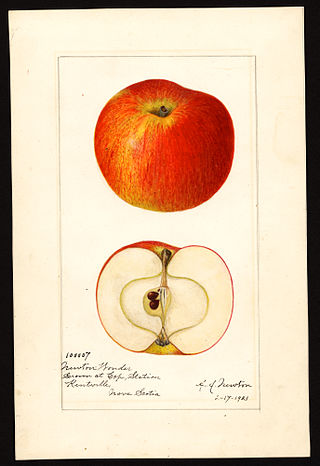
Malus domestica Newton Wonder is a cultivar of apple which is usually eaten cooked due to its sourness. The variety has a similar but slightly sweeter taste than the Bramley apple and is usually used in pies or as a preserve.

'Akane', also known as 'Tokyo Rose', 'Tohoku No.3' and 'Prime Red', is a Japanese cultivar of domesticated apple, that according to Orange Pippin is one of the best early season apples.

'Worcester Pearmain' is an early season English cultivar of domesticated apple, that was developed in Worcester, England, by a Mr. Hale of Swanpool in 1874. It was once the most popular cultivar in England for early autumn harvest and is still popular to keep in the garden. It has been extensively used in apple breeding.

'Allington Pippin' is an English cultivar of domesticated apple, with a strong flavour that includes hints of pineapple.
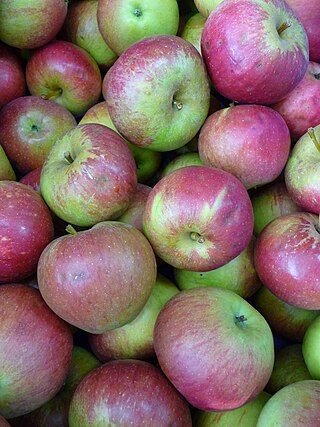
Fiesta is a modern cultivar of domesticated apple which is often marketed as Red Pippin. It was developed in the United Kingdom by breeders at the East Malling Research Station, combining the Cox's Orange Pippin with the Idared apple. According to the Orange Pippin website, it is one of the best Cox's style apples, but much easier to grow having good disease resistance.
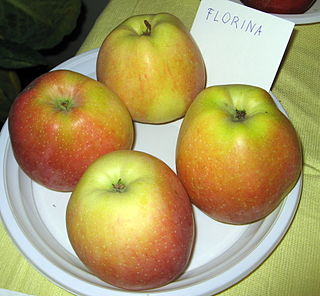
Florina which is also called Querina, is a French cultivar of domesticated apple, that has combined traits of the Jonathan, Golden Delicious and Rome apples, and was developed in Angers, France, by the "Station de Recherches d'Arboriculture Fruitiere". Although developed in France its ancestry is entirely American.
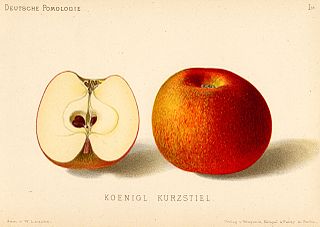
Court Pendu Plat is an extremely old French cultivar of domesticated apple that was first recorded in 1613. The cultivar definitely dates back to earlier than the 17th century, and was probably cultivated by the Romans. It is known for its intense flavor which mellows with storage.

Flamenco, also known as Ballerina Obelisk, is a cultivar of domesticated apple that bears apples good for eating fresh, and is grown for its unusual ornamental properties. The tree grows in a straight up columnar style, with many small fruit-bearing branches. 'Flamenco' is one of a series of apple tree cultivars that share a registered trademark under the name Ballerina.

Splendour, Splendor or Starksplendor is a modern cultivar of domesticated apple which was developed in New Zealand, and is regarded there as a popular commercial dessert apple. It has been said to be a cross between 'Red Dougherty' and 'Golden Delicious', but genetic analysis has not definitely characterized either of the parent cultivars, and records do not indicate known or suspected parents.
